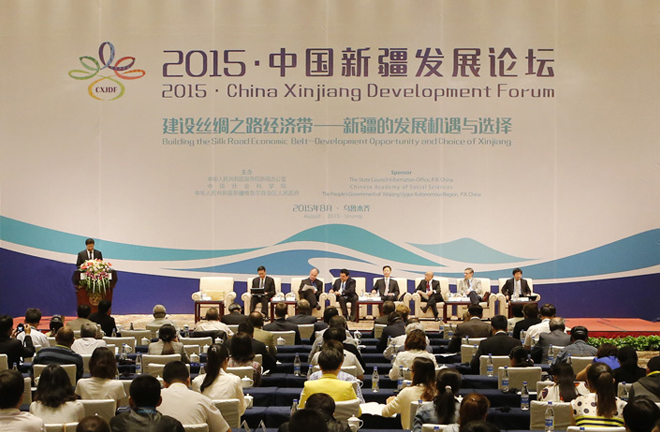Silk Road belt to drive development in Xinjiang

The 2015 China Xinjiang Development Forum is held in Urumqi, capital of China's Xinjiang Uygur Autonomous Region from Aug.18 to 19.
The 2015 China Xinjiang Development Forum was held in Urumqi, capital of China's Xinjiang Uygur Autonomous Region from Aug. 18 to 19. Themed "Building the Silk Road Economic Belt: Development Opportunity and Choice of Xinjiang," the forum marked the 60th anniversary of the establishment of the autonomous region.
The two-day forum attracted about 100 people from 30 countries and international organizations to discuss the construction of the core area of the Silk Road Economic Belt and cooperation with neighboring countries.
Located in the northwest of China, Xinjiang is an indisputable part of Chinese territory. It is a place where Eastern and Western civilizations blend together, multiple ethnic groups live together, and different religions and cultures coexist. And the establishment of the autonomous region in 1955 started a new chapter for economic and social development in the area.
In the past 60 years, Xinjiang has seen rapid economic growth. Its GDP reached more than 900 billion yuan ($140 billion), a hundredfold increase relative to 1955. Since the central work conference on Xinjiang's development in 2010, it has grown at a rate of more than 10 percent for five consecutive years.
“It is the system of regional ethnic autonomy that has guaranteed social and economic development in the area,” said Mulati Heiniyati, director of the Institute of Philosophy at the Xinjiang Academy of Social Sciences. The system ensures equal rights for these ethnic groups, cultivates cadres with political integrity and professional competence, and protects ethnic culture and religious freedom, he said.
Xinjiang is located in the heart of the ancient Silk Road, and it is a significant window for opening to the West. It has been identified as a core area of the Silk Road Economic Belt, which presents a historic opportunity for development in the region.
Zhang Chunxian, secretary of the Party committee of the autonomous region, said in his speech that Xinjiang is gearing up its efforts to become a hub for transportation, trade, culture, education, regional finance and healthcare. To this end, four things should be prioritized: expanding the passageway westward, opening up in an all-round way, promoting cultural exchanges and strengthening security cooperation, he added.
Zhao Shengxuan, vice-president of the Chinese Academy of Social Sciences, said the construction of the economic belt will give full play to the role of Xinjiang as China’s frontline in opening up to the West. It will become a bridge for all countries along the economic belt to achieve cooperative construction and mutual benefit.
“Friendly neighborhood” and “interconnectivity” are also hot topics at the forum. Interconnection between Xinjiang and neighboring areas is essential to the realization of the goals of the economic belt and the construction of its core area. “Xinjiang would like to join hands with other nations along the economic belt in promoting peaceful development and mutually beneficial cooperation in order to create a bright future for Asia and Europe,” said Gao Jianlong, president of the Xinjiang Academy of Social Sciences.
He Lunzhi, director of the Institute of Economic Research at Xinjiang University, suggested that construction of the core area prioritize road connection while optimizing the environment for trade and monetary circulation, adding that policy communication and public support are also needed.
Zhang Chunhai is a reporter at the Chinese Social Sciences Today.
